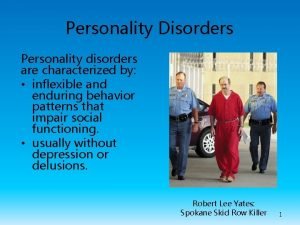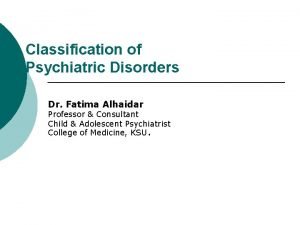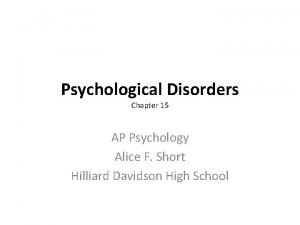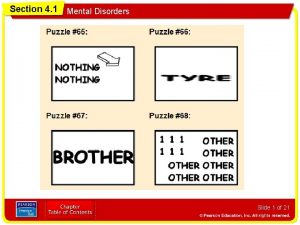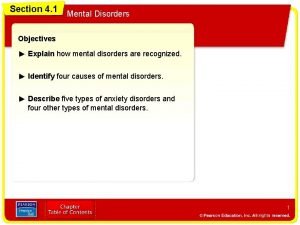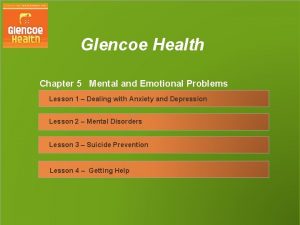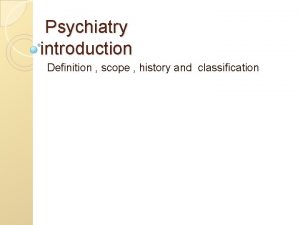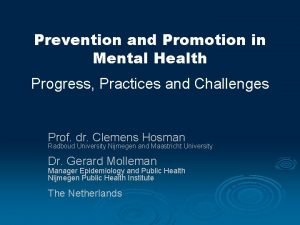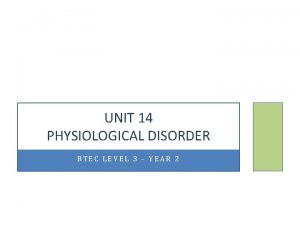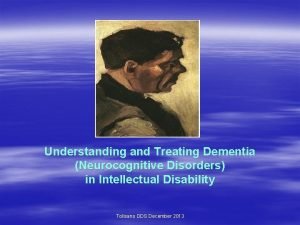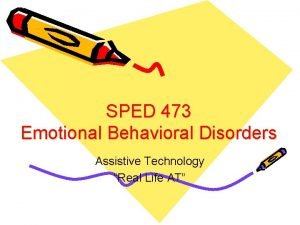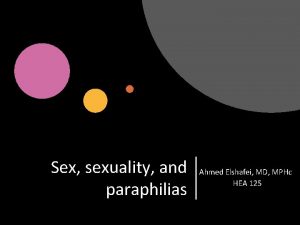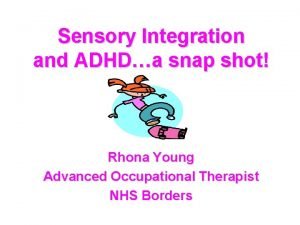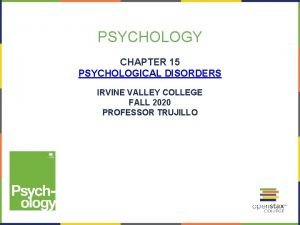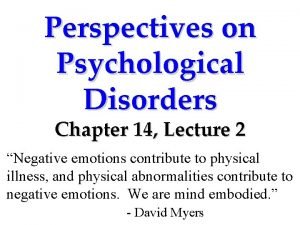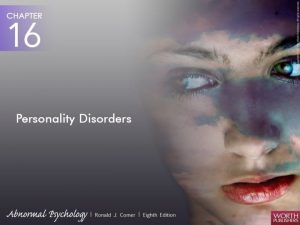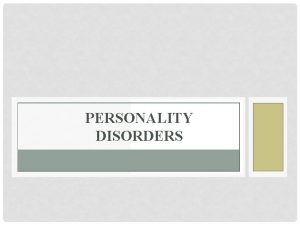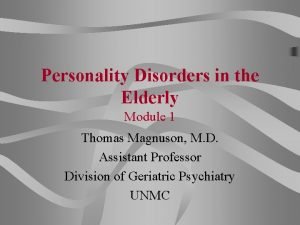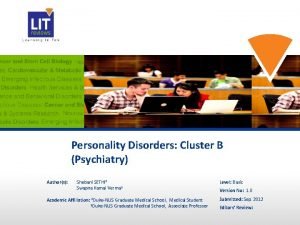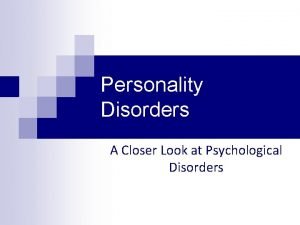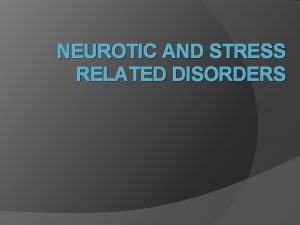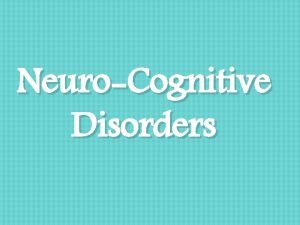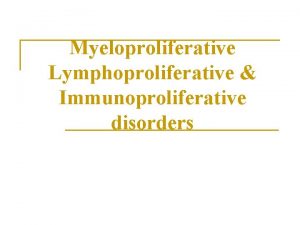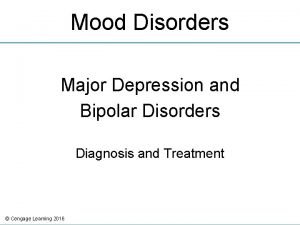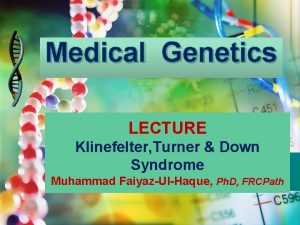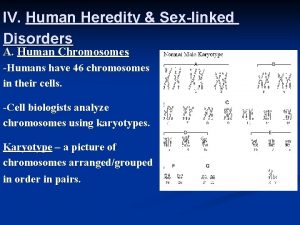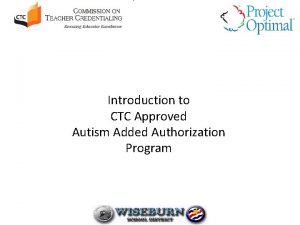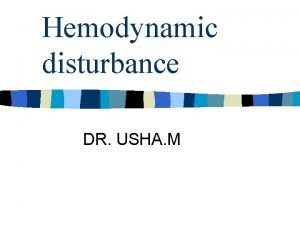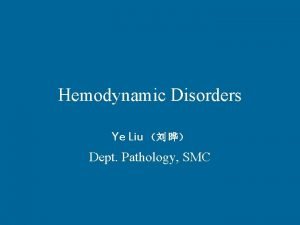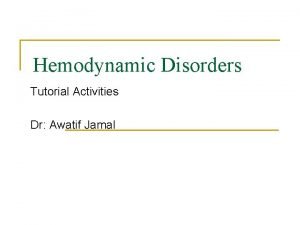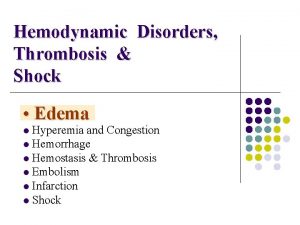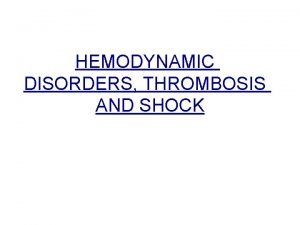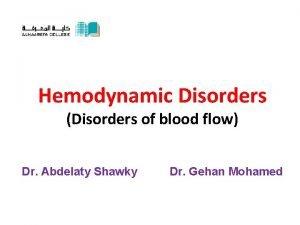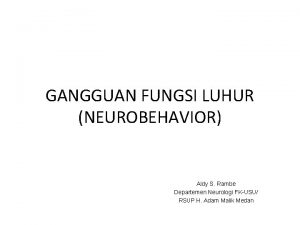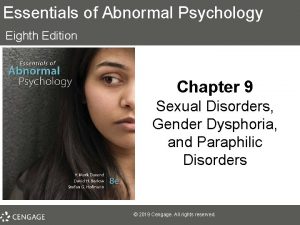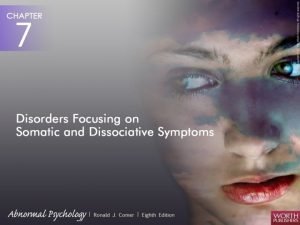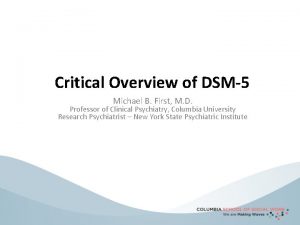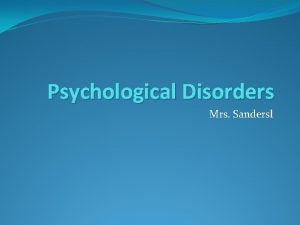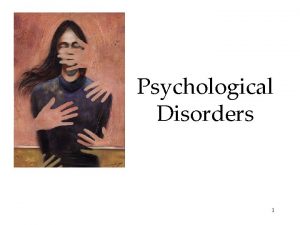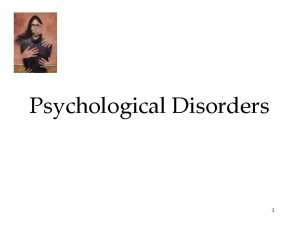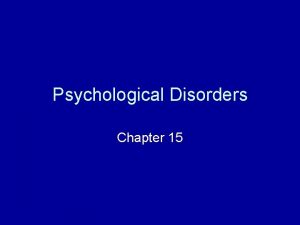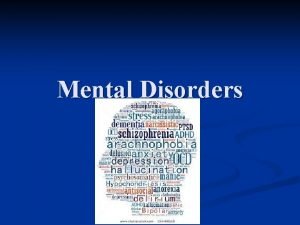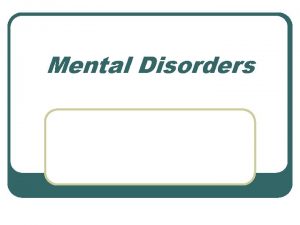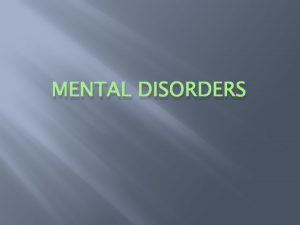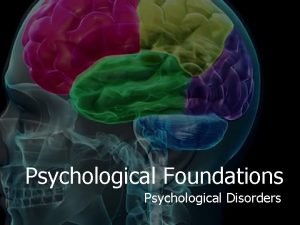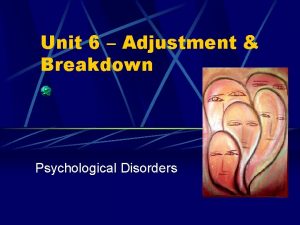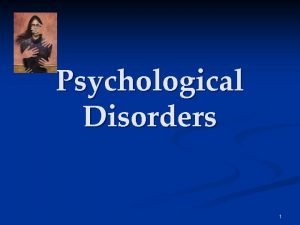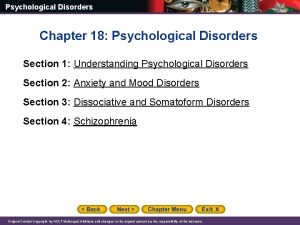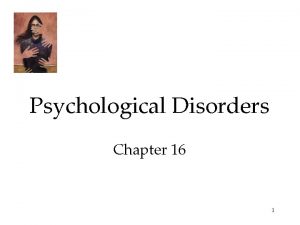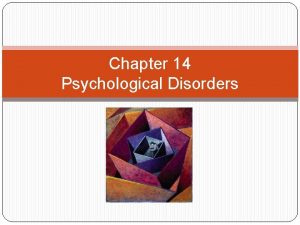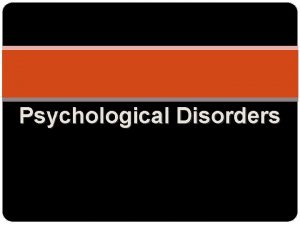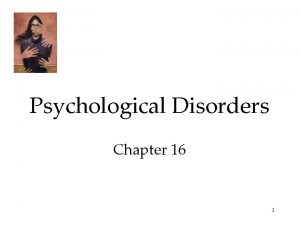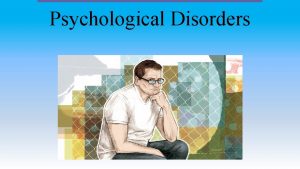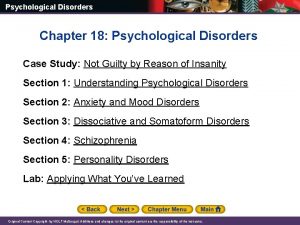Psychological Disorders History of Mental IllnessTedtalk People are



















































![Disorganized & Delusional Thinking This morning when I was at Hillside [Hospital], I was Disorganized & Delusional Thinking This morning when I was at Hillside [Hospital], I was](https://slidetodoc.com/presentation_image/26ab664be4a351bfd0526949434faf65/image-52.jpg)



















- Slides: 71


Psychological Disorders History of Mental Illness-Tedtalk People are fascinated by the exceptional, the unusual, and the abnormal. This fascination may be caused by two reasons: 1. During various moments we feel, think, and act like an abnormal individual. 2. Psychological disorders may bring unexplained physical symptoms, irrational fears, and suicidal thoughts.

Psychological Disorders To study the abnormal is the best way of understanding the normal. William James (1842 -1910) 1. There are 450 million people suffering from psychological disorders (WHO, 2004). 2. Depression and schizophrenia exist in all cultures of the world.

Defining Psychological Disorders Mental health workers view psychological disorders as persistently harmful thoughts, feelings, and actions. When behavior is deviant, distressful, and dysfunctional psychiatrists and psychologists label it as disordered (Comer, 2004).

Deviant, Distressful & Dysfunctional Carol Beckwith 1. Deviant behavior (going naked) in one culture may be considered normal, while in others it may lead to arrest. 2. Deviant behavior must accompany distress. 3. If a behavior is dysfunctional it is clearly a disorder. In the Wodaabe tribe men wear costumes to attract women. In Western society this would be considered abnormal.

Understanding Psychological Disorders Ancient Treatments of psychological disorders include trephination, exorcism, being caged like animals, being beaten, burned, castrated, mutilated, or transfused with animal’s blood. John W. Verano Trephination (boring holes in the skull to remove evil forces)

Medical Model When physicians discovered that syphilis led to mental disorders, they started using medical models to review the physical causes of these disorders. 1. 2. 3. 4. Etiology: Cause and development of the disorder. Diagnosis: Identifying (symptoms) and distinguishing one disease from another. Treatment: Treating a disorder in a psychiatric hospital. Prognosis: Forecast about the disorder. *Fails to recognize the effect of social and psychological factors!

The Biopsychosocial Approach Assumes that biological, socio-cultural, and psychological factors combine and interact to produce psychological disorders.

Classifying Psychological Disorders • Diagnostic and Statistical Manual of Mental Disorders (DSM) • International Classification of Diseases (ICD-10) • Criticisms of the DSM

Classifying Psychological Disorders


Classifying Psychological Disorders

Abnormal Psychology in the Media In Groups: 1. Choose 2 clips to watch from the following website: https: //www. youtube. com/playlist? list=PL 81 C 8 C 21394 E 2 A 94 D 2. Compare what you watch to what is in the DSM-IV/V. Do they match 3. Evaluate whether you think the portrayal promotes sensitivity or further stigma toward the particular mental illness

Fig. 14 -4, p. 556

Labeling Psychological Disorders: Some psychologists criticize the use of labeling. • • Critics of the DSM argue that labels may stigmatize individuals. Labels may become self-fulfilling. Some psychologists find diagnostic labels useful. • Labels may be helpful for healthcare professionals when communicating with one another and establishing therapy.

Labeling Psychological Disorders Elaine Thompson/ AP Photo “Insanity” labels raise moral and ethical questions about how society should treat people who have disorders and have committed crimes. Theodore Kaczynski (Unabomber)

Anxiety Disorders Do I have an anxiety disorder? Feelings of excessive apprehension and anxiety. 1. 2. 3. 4. 5. Generalized anxiety disorder Panic disorder Phobias Obsessive-compulsive disorder Post-traumatic stress disorder

Generalized Anxiety Disorder Symptoms 1. Persistent and uncontrollable tenseness and apprehension. 2. Autonomic arousal. 3. Inability to identify or avoid the cause of certain feelings, this is an anxiety which Freud labeled free floating.

Panic Disorder Symptoms Minutes-long episodes of intense dread which may include feelings of terror, chest pains, choking, or other frightening sensations. Anxiety is a component of both disorders. It occurs more in the panic disorder, making people avoid situations that cause it. Smokers have at least doubled risk of panic disorder.

Phobias Marked by a persistent and irrational fear of an object or situation that disrupts behavior.

Kinds of Phobias Agoraphobia Acrophobia Claustrophobia Phobia of open places. Phobia of heights. Phobia of closed spaces. Hemophobia Phobia of blood. Social phobia Shyness to an extreme

Obsessive-Compulsive Disorder Persistence of unwanted thoughts (obsessions) and urges to engage in senseless rituals (compulsions) that cause distress.

Brain Imaging A PET scan of the brain of a person with Obsessive -Compulsive Disorder (OCD). High metabolic activity (red) in the frontal lobe areas are involved with directing attention.

Post-Traumatic Stress Disorder Four or more weeks of the following symptoms constitute post-traumatic stress disorder (PTSD): 1. Haunting memories 2. Nightmares 3. Social withdrawal 5. Sleep problems Bettmann/ Corbis 4. Jumpy anxiety

Resilience to PTSD Only about 10% of women and 20% of men react to traumatic situations and develop PTSD. Holocaust survivors show remarkable resilience against traumatic situations. All major religions of the world suggest that surviving a trauma leads to the growth of an individual. Post-traumatic growth is a theory in which challenging crises or traumatic experiences increases personal strength, positively shifts priorities and promotes spirituality.

Explaining Anxiety Disorders Freud suggested that we repress our painful and intolerable ideas, feelings, and thoughts, resulting in anxiety.

The Learning Perspective Learning theorists suggest two specific learning processes which contribute to anxiety: 1. Fear conditioning leads to anxiety. This anxiety then becomes associated with other objects or events (stimulus generalization). 2. Reinforcement maintains our phobias and compulsions when we avoid or escape the feared situation to reduce anxiety.

The Learning Perspective Investigators believe that fear responses are reinforced through observational learning. Young monkeys develop fear when they watch other monkeys who are afraid of snakes.

The Biological Perspective Natural Selection has led our ancestors to learn to fear snakes, spiders, and other animals. Therefore, fear preserves the species. Twin studies suggest that our genes may be partly responsible for developing fears and anxiety. Twins are more likely to share phobias.

The Biological Perspective Anterior Cingulate Cortex of an OCD patient. S. Ursu, V. A. Stenger, M. K. Shear, M. R. Jones, & C. S. Carter (2003). Overactive action monitoring in obsessive-compulsive disorder. Psychological Science, 14, 347 -353. Generalized anxiety, panic attacks, and even OCD are linked with brain circuits like the anterior cingulate cortex. When given challenging, cognitive tasks, these patients show elevated activity in the anterior cingulate cortex.

Somatoform Disorders • Symptoms mimic a physical disease or injury. • Medical test results are either normal or do not explain the person’s symptoms. • One type of somatoform disorder is conversion disorder in which very specific genuine physical symptoms exist for which no physiological basis can be found. • Hypochondriasis is a somatoform disorder in which a person interprets normal physical sensations as symptoms of a disease.

Dissociative Disorders Conscious awareness becomes separated (dissociated) from previous memories, thoughts, and feelings. Symptoms 1. Having a sense of being unreal. 2. Being separated from the body. 3. Watching yourself as if in a movie.

Dissociative Identity Disorder (DID) Herschell Walker-Living with Dissociative Disorder A disorder in which a person exhibits two or more distinct and alternating personalities, formerly called multiple personality disorder. Lois Bernstein/ Gamma Liason Chris Sizemore (DID)

DID Critics argue that the diagnosis of DID increased in the late 20 th century. DID has not been found in other countries. Critics’ Arguments 1. Role-playing by people open to a therapist’s suggestion. 2. Learned response that reinforces reductions in anxiety.

Mood Disorders Emotional extremes of mood disorders come in two principal forms. 1. Major depressive disorder 2. Bipolar disorder

Major Depressive Disorder Depression is the “common cold” of psychological disorders. In a year, 5. 8% of men and 9. 5% of women report depression worldwide (WHO, 2002). Blue mood Major Depressive Disorder Gasping for air after a hard run Chronic shortness of breath

Major Depressive Disorder Major depressive disorder occurs when signs of depression last two weeks or more and are not caused by drugs or medical conditions. 1. 2. 3. 4. Signs include: Lethargy and fatigue Feelings of worthlessness Loss of interest in family & friends Loss of interest in activities

Bipolar Disorder Formerly called manic-depressive disorder. An alternation between depression and mania signals bipolar disorder. Depressive Symptoms Manic Symptoms Gloomy Elation Withdrawn Euphoria Inability to make decisions Tired Slowness of thought Desire for action Hyperactive Multiple ideas

Bipolar Disorder Many great writers, poets, and composers suffered from bipolar disorder. During their manic phase creativity surged, but not during their depressed phase. Clemens Hemingway Earl Theissen/ Hulton Getty Pictures Library The Granger Collection Wolfe George C. Beresford/ Hulton Getty Pictures Library Bettmann/ Corbis Whitman

Explaining Mood Disorders Depression theories and treatments clip Since depression is so prevalent worldwide, investigators want to develop a theory of depression that will suggest ways to treat it. Lewinsohn et al. , (1985, 1998) note that a theory of depression should explain the following: 1. Behavioral and cognitive changes 2. Common causes of depression

Theory of Depression 3. Gender differences

Theory of Depression 4. Depressive episodes self-terminate. 5. Stressful events often precede depression. 6. Depression is increasing, especially in the teens. Desiree Navarro/ Getty Images Post-partum depression

Suicide The most severe form of behavioral response to depression is suicide. Each year some 1 million people commit suicide worldwide. 1. 2. 3. 4. 5. Suicide Statistics National differences Racial differences Gender differences Age differences Other differences

Comparative Suicide Rates • National Differences: Britain, Italy & Spain’s rates are little more than half that of the US, Canada and Australia. Austria & Finland are double. • Racial Differences: In the US, whites are 2 x as likely than blacks. • Gender Differences: Women are more likely to attempt, men are more likely to succeed. • Age Differences: Rates increase dramatically in late adulthood, especially among men. • Other: Rates are higher among the rich, nonreligious and those who are single, widowed or divorced. In the last 60 years, the global rate of annual suicide rose from 10 to 18 per 100, 000. In 2006 in the US, suicide per 100, 000: 11. 1 (or 33, 300 people).

Biological Perspective Genetic Influences: Mood disorders run in families. The rate of depression is higher in identical (50%) than fraternal twins (20%). Jerry Irwin Photography Linkage analysis and association studies link possible genes and dispositions for depression.

The Depressed Brain PET scans show that brain energy consumption rises and falls with manic and depressive episodes. Courtesy of Lewis Baxter an Michael E. Phelps, UCLA School of Medicine

Social-Cognitive Perspective The social-cognitive perspective suggests that depression arises partly from self-defeating beliefs and negative explanatory styles.

Negative Thoughts and Moods Explanatory style plays a major role in becoming depressed.

Depression Cycle 1. Negative stressful events. 2. Pessimistic explanatory style. 3. Hopeless depressed state. 4. These hamper the way the individual thinks and acts, fueling personal rejection.

Schizophrenia The literal translation is “split mind” which refers to a split from reality. A group of severe disorders characterized by the following: 1. Disorganized and delusional thinking. 2. Disturbed perceptions. 3. Inappropriate emotions and actions. Living with Schizophrenia Clip

Symptoms of Schizophrenia Positive symptoms: the presence of inappropriate behaviors (hallucinations, disorganized or delusional talking) Negative symptoms: the absence of appropriate behaviors (expressionless faces, rigid bodies)
![Disorganized Delusional Thinking This morning when I was at Hillside Hospital I was Disorganized & Delusional Thinking This morning when I was at Hillside [Hospital], I was](https://slidetodoc.com/presentation_image/26ab664be4a351bfd0526949434faf65/image-52.jpg)
Disorganized & Delusional Thinking This morning when I was at Hillside [Hospital], I was making a movie. I was surrounded by movie stars … I’m Mary Poppins. Is this room painted blue to get me upset? My grandmother died four weeks after my eighteenth birthday. ” (Sheehan, 1982) Other forms of delusions of This monologue illustratesinclude, fragmented, bizarre persecution is following me”) or thinking with (“someone distorted beliefs called delusions grandeur (“I am a king”). (“I’m Mary Poppins”).

Disorganized & Delusional Thinking Many psychologists believe disorganized thoughts occur because of selective attention failure (fragmented and bizarre thoughts).

Disturbed Perceptions A schizophrenic person may perceive things that are not there (hallucinations). Frequently such hallucinations are auditory and lesser visual, somatosensory, olfactory, or gustatory. L. Berthold, Untitled. The Prinzhorn Collection, University of Heidelberg August Natter, Witches Head. The Prinzhorn Collection, University of Heidelberg Photos of paintings by Krannert Museum, University of Illinois at Urbana-Champaign

Inappropriate Emotions & Actions A schizophrenic person may laugh at the news of someone dying or show no emotion at all (flat affect). Patients with schizophrenia may continually rub an arm, rock a chair, or remain motionless for hours (catatonia).

Onset and Development of Schizophrenia Nearly 1 in a 100 suffer from schizophrenia, and throughout the world over 24 million people suffer from this disease (WHO, 2002). Schizophrenia strikes young people as they mature into adults. It affects men and women equally, but men suffer from it more severely than women.

Chronic and Acute Schizophrenia When schizophrenia is slow to develop (chronic/process) recovery is doubtful. Such schizophrenics usually display negative symptoms. When schizophrenia rapidly develops (acute/reactive) recovery is better. Such schizophrenics usually show positive symptoms.

Understanding Schizophrenia is a disease of the brain exhibited by the symptoms of the mind. Brain Abnormalities Dopamine Overactivity: Researchers found that schizophrenic patients express higher levels of dopamine D 4 receptors in the brain.

Abnormal Brain Activity Brain scans show abnormal activity in the frontal cortex, thalamus, and amygdala of schizophrenic patients. Paul Thompson and Arthur W. Toga, UCLA Laboratory of Neuro Imaging and Judith L. Rapport, National Institute of Mental Health

Abnormal Brain Morphology Schizophrenia patients may exhibit morphological changes in the brain like enlargement of fluid-filled ventricles. Both Photos: Courtesy of Daniel R. Weinberger, M. D. , NIH-NIMH/ NSC

Viral Infection Schizophrenia has also been observed in individuals who contracted a viral infection (flu) during the middle of their fetal development.

Genetic Factors The likelihood of an individual suffering from schizophrenia is 50% if their identical twin has the disease (Gottesman, 2001). 0 Identical Both parents Fraternal One parent Sibling Nephew or niece Unrelated 10 20 30 40 50

Genetic Factors The following shows the prevalence of schizophrenia in identical twins as seen in different countries.

Psychological Factors Psychological and environmental factors can trigger schizophrenia if the individual is genetically predisposed (Nicol & Gottesman, 1983). Courtesy of Genain Family Genain Sisters The genetically identical Genain sisters suffer from schizophrenia. Two more than others, thus there are contributing environmental factors.

Personality Disorders Personality disorders are characterized by inflexible and enduring behavior patterns that impair social functioning. They are usually without anxiety, depression, or delusions.

Antisocial Personality Disorder A disorder in which the person (usually men) exhibits a lack of conscience for wrongdoing, even toward friends and family members. Formerly, this person was called a sociopath or psychopath. Symptoms May Include: • Lack of empathy or affection. • No regard for right and wrong. • Using charm or wit to manipulate others. • Intimidation of others. • Violent or aggressive behavior.

Antisocial Personality Disorder Some have trouble functioning normally in society: trouble with relationships and with the law. Others are very successful and mimicking emotion and general deception.

Understanding Antisocial Personality Disorder Like mood disorders and schizophrenia, antisocial personality disorder has biological and psychological reasons. Youngsters, before committing a crime, respond with lower levels of stress hormones than others do at their age.

Understanding Antisocial Personality Disorder PET scans of 41 murderers revealed reduced activity in the frontal lobes. In a follow-up study, repeat offenders had 11% less frontal lobe activity (Raine et al. , 1999; 2000). Courtesy of Adrian Raine, University of Southern California Normal Murderer

Rates of Psychological Disorders

Rates of Psychological Disorders The prevalence of psychological disorders during the previous year is shown below (WHO, 2004).
 Antigentest åre
Antigentest åre Medical model psychology
Medical model psychology Inflexible personality
Inflexible personality Psychiatric disorders
Psychiatric disorders Chapter 18 psychological disorders
Chapter 18 psychological disorders Chapter 14 psychological disorders
Chapter 14 psychological disorders Chapter 14 psychological disorders
Chapter 14 psychological disorders Bipolar
Bipolar Ap psychology chapter 15 psychological disorders
Ap psychology chapter 15 psychological disorders Section 4-1 mental disorders answers
Section 4-1 mental disorders answers Section 4-1 mental disorders answers
Section 4-1 mental disorders answers Chapter 21 mental health diseases and disorders
Chapter 21 mental health diseases and disorders Impulse control problems
Impulse control problems Chapter 5 lesson 4 getting help answer key
Chapter 5 lesson 4 getting help answer key Classification of mental disorders
Classification of mental disorders Mental health disorders
Mental health disorders Mental health and mental illness chapter 20
Mental health and mental illness chapter 20 Mental health jeopardy
Mental health jeopardy Describe this type of people as media
Describe this type of people as media Black eyed peas
Black eyed peas Transformed people transform people
Transformed people transform people Justpeople
Justpeople History helps us understand people and societies
History helps us understand people and societies Throughout history people
Throughout history people Mounds
Mounds History also history physical
History also history physical Physiological disorders unit 14
Physiological disorders unit 14 Unit 14 physiological disorders assignment 1
Unit 14 physiological disorders assignment 1 Neurocognitive disorders
Neurocognitive disorders Bipolar and other related disorders
Bipolar and other related disorders Bipolar and other related disorders
Bipolar and other related disorders Flinders model of chronic care self-management limitations
Flinders model of chronic care self-management limitations Assistive technology for behavior
Assistive technology for behavior Somatization disorder
Somatization disorder Egodystonic
Egodystonic Types of sensory disorders
Types of sensory disorders Puberty and autism spectrum disorders
Puberty and autism spectrum disorders Diathesis stress model
Diathesis stress model Paranoid personality disorder
Paranoid personality disorder Axis 1 and axis 2 disorders
Axis 1 and axis 2 disorders Avoidant personality traits
Avoidant personality traits Dsm v personality disorders
Dsm v personality disorders Cluster c personality disorder
Cluster c personality disorder Cluster b personality traits
Cluster b personality traits Cluster a personality disorders
Cluster a personality disorders Eat disorder york
Eat disorder york Neurotic stress related and somatoform disorders
Neurotic stress related and somatoform disorders Neurocognitive disorders
Neurocognitive disorders Immunoproliferative disorders examples
Immunoproliferative disorders examples Mood disorders
Mood disorders Orotic aciduria
Orotic aciduria Purine disorders
Purine disorders Down turner and klinefelter syndrome
Down turner and klinefelter syndrome What is a sex linked disorder
What is a sex linked disorder Unit 14 physiological disorders assignment 1
Unit 14 physiological disorders assignment 1 Added authorization in autism spectrum disorders
Added authorization in autism spectrum disorders Chapter 11 genetic disorders concept mapping
Chapter 11 genetic disorders concept mapping Difference between renal and cardiac edema
Difference between renal and cardiac edema Hemodynamic disorders
Hemodynamic disorders Cerebral infarction
Cerebral infarction Edema heart
Edema heart Edema robbins
Edema robbins Hemodynamic disorders
Hemodynamic disorders Neurobehavioral disorders list
Neurobehavioral disorders list Hemodynamic disorders
Hemodynamic disorders Causes of paraphilic disorders
Causes of paraphilic disorders Eating disorders in uae
Eating disorders in uae Sarah fogarty
Sarah fogarty Dissociative disorders
Dissociative disorders Attachment issues
Attachment issues Dsm v sexual disorders
Dsm v sexual disorders Congenital voice disorders
Congenital voice disorders


